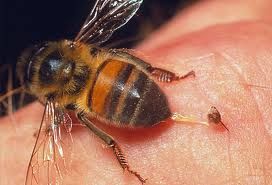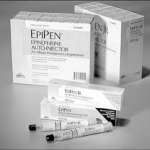Bee, wasp, yellow jacket, hornet, or fire ant stings are the insect stings that most often trigger allergies. However, most people are not allergic to insect stings and may mistake a normal sting reaction for an allergic reaction. By knowing the difference, you can prevent unnecessary worry and visits to the doctor.
 The severity of an insect sting reaction varies from person to person. There are three types of reactions — normal, localized, and allergic:
The severity of an insect sting reaction varies from person to person. There are three types of reactions — normal, localized, and allergic:
- A normal reaction will result in pain, swelling, and redness around the sting site.
- A large local reaction will result in swelling that extends beyond the sting site. For example, a person stung on the ankle may have swelling of the entire leg. While it often looks alarming, it is generally no more serious than a normal reaction.
- The most serious reaction to an insect sting is an allergic one (described below). This condition requires immediate medical attention.
The process of sting-induced allergies is poorly understood. Like other allergies, being allergic to stings appears to run in families. But scientists still don’t understand why only 60% of allergic adults and 8% of allergic children suffer shock when they are stung.
A person may be stung many times during his lifetime — and have only normal reactions — then suddenly one sting will produce a strong allergic reaction. Doctors are not sure why a person develops such sensitivity or why the sensitivity may last fewer than three months or more than 25 years.
What Are the Symptoms of an Insect Sting Allergy?
Symptoms of a severe insect sting allergy (called an anaphylactic reaction) may include one or more of the following:
- Difficulty breathing
- Hives that appear as a red, itchy rash and spread to areas beyond the sting
- Swelling of the face, throat, or mouth tissue
- Wheezing or difficulty swallowing
- Restlessness and anxiety
- Rapid pulse
- Dizziness or a sharp drop in blood pressure
Although severe allergic reactions are not that common, they can lead to shock, cardiac arrest, and unconsciousness in 10 minutes or less. This type of reaction can occur within minutes after a sting and can be fatal. Get emergency treatment as soon as possible.
A mild allergic reaction to an insect sting may cause one or more of the following symptoms at the site of the sting:
- Pain
- Redness
- Pimple-like spots
- Mild to moderate swelling
- Warmth at the sting site
- Itching
People who have experienced an allergic reaction to an insect sting have a 60% chance of a similar or worse reaction if they are stung again.
How Common Are Insect Sting Allergies?
 About 2 million Americans have allergies to the venom of stinging insects. Many of these individuals are at risk for life-threatening allergic reactions. Approximately 50 deaths each year in the U.S. are attributed to insect sting allergies.
About 2 million Americans have allergies to the venom of stinging insects. Many of these individuals are at risk for life-threatening allergic reactions. Approximately 50 deaths each year in the U.S. are attributed to insect sting allergies.
How Are Allergic Sting Reactions Treated?
Severe allergic sting reactions are treated with epinephrine (adrenaline), either self-injected or administered by a doctor. Usually this injection will stop the development of a more severe allergic reaction.
In some cases, intravenous fluids, oxygen, and other treatments are also necessary. Once stabilized, you are sometimes required to stay overnight at the hospital under close observation. People who have had previous allergic reactions to an insect sting must remember to carry epinephrine with them wherever they go. Also, because one dose may not be enough to reverse an allergic reaction, immediate medical attention following an insect sting is still recommended.
What Are Epinephrine Sting Kits?
 Epinephrine sting kits can be self administered and are important for you to use immediately after being stung, before you get to a doctor for treatment. The two most common have the brand names Ana-Kit and Epi-Pen. However, these kits should not be used as a substitute for medical intervention. You should still see a doctor after being stung. Epinephrine alone is not always enough to reverse serious allergic sting reactions and may cause serious side effects in some people with heart conditions or people who are taking certain medicines.
Epinephrine sting kits can be self administered and are important for you to use immediately after being stung, before you get to a doctor for treatment. The two most common have the brand names Ana-Kit and Epi-Pen. However, these kits should not be used as a substitute for medical intervention. You should still see a doctor after being stung. Epinephrine alone is not always enough to reverse serious allergic sting reactions and may cause serious side effects in some people with heart conditions or people who are taking certain medicines.
You will need a prescription from your doctor to purchase one of these kits. Before using, be sure to let your doctor know about any medicine you are taking to prevent drug interactions.
How Can I Prevent an Allergic Reaction to an Insect Sting?
Allergic reactions to insect stings can be prevented with allergy shots. The treatment is about 97% effective in preventing future reactions and involves injecting gradually increasing doses of venom that stimulate your immune system to become resistant to a future allergic reaction.
If you’ve had an allergic reaction, it’s important to talk to an allergist, a doctor who specializes in the diagnosis and treatment of allergic disease. Based on your history and test results, the allergist will determine if you are a candidate for immunotherapy treatment.